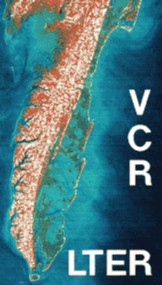 Biotic mechanisms influencing seeding establishment during primary succession on a Virginia barrier island |

Tolliver, K. and D.R. Young
Department of Biology
|
 Biotic mechanisms influencing seeding establishment during primary succession on a Virginia barrier island |

Tolliver, K. and D.R. Young
Department of Biology
|
TOLLIVER, KATHRYN S. and D.R. YOUNG. Virginia Commonwealth University, Richmond, VA. Biotic mechanisms influencing seedling establishment during primary succession on a Virginia barrier island.
Elucidating mechanisms influencing the establishment of woody species is essential for understanding community dynamics and successional processes on barrier islands. The relative intensity of facilitation and inhibition of grasses on seedling establishment of two woody species common to Atlantic Coast barrier islands, Myrica cerifera and Baccharis halimifolia, were examined in a grassy swale on Hog Island. Physiological responses were quantified in a factorial experiment that included above-ground clipping and root exclosure treatments. In addition, insect herbivore damage was categorized by degree of above-ground tissue damage, and mortality was monitored. Soil surface temperature significantly decreased with grasses. Additionally, during periods of reduced water stress, soil water content and plant water status increased with grasses. However, during periods of water stress, net photosynthesis for Myrica was greater in treatments without above or below-ground competition. Additionally, Myrica growth integrated over the season was greatest in treatments without above or below-ground competition. In contrast, Baccharis growth was greatest and mortality lowest in the presence of grasses, with mortality occurring only in seedlings with severe herbivore damage. Thus, based on this field season, biotic mechanisms of facilitation and inhibition by grasses, as well as herbivory, may influence woody seedling establishment, with temporal and species specific differences varying with intensity of water stress.